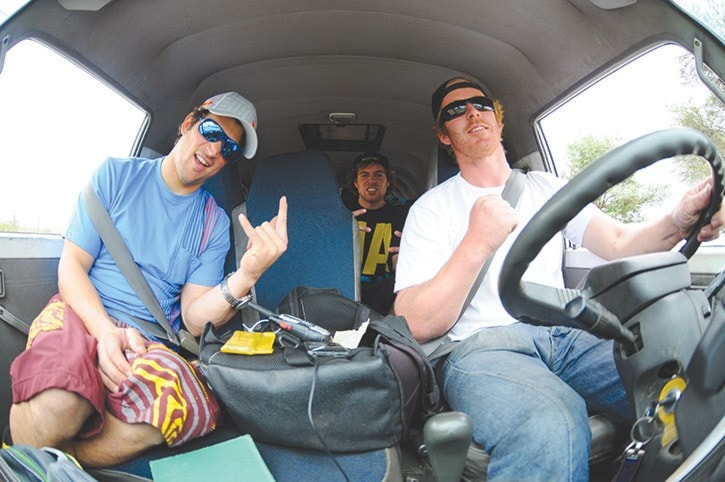This is the first part in a three-part series that examines the Cariboo’s involvement with the recently released mountain bike film Where The Trail Ends. Three individuals from the region were involved with the film which is a reflection of how significant mountain biking is becoming in this area.
John Wellburn, who is a frequent contributor to www.ridetheacariboo.ca website and the consortium’s work in general was one of the producers for Where The Trail Ends. We caught up with John from his home in Mendoza, Argentina to talk about his role in the film.
Consortium: Tell us about how you got involved with Freeride Entertainment and the Where The Trail Ends Project?
Wellburn: I got a call from Jeremy Grant, the director of the film in 2009 after meeting him through Mike Kinrade. Mike and Jeremy wanted to do a trip and had there eyes on Argentina. They needed a photographer and someone to set stuff up on the ground etc. The plan was to shoot a short piece for the Banff Film Festival, a film that would come to be called the Argentine Project. After a few phone calls, we arranged the trip. It was on that trip that we discovered the potential of the Salta area.. In a matter of speaking, the Where The Trail Ends project was born after that trip.
Consortium: You are one of the producers of the film. Tell us about that role and the kinds of things you were responsible for?
Wellburn: Generally, I was the man on the ground. There is a huge amount of logistics that go into these films. From translation, accommodations, transportation, location management and all the little details that make the film work is the responsibility of the producer. Once the film was born, I worked with Derek Westerland from Freeride to coordinate and fine tune the details of the Fraser and Argentina segments. We hatched over details and logistics before trips on the phone before and throughout the trips.
Consortium: You are based in Argentina for half of the year. You own the Alltimerides touring company, have a house there and speak the language, so obviously you had a huge role in managing the Salta location. Tell us about that part of the film?
Wellburn: I was familiar with Salta from the 2009 project with Kinrade, so I had a good idea of what it would take for Where The Trail Ends to pull off this segment. One of the things that had changed from the 2009 shoot was that part of the area had become a park when we returned. So after a few days of filming, the Argentine Park Rangers showed up to find out what we were doing. I spent two days on the phone with Government officials working with them to coordinate the film. In the end it worked out fine and they were satisfied that we were not damaging the environment, but that gives you some idea of what my role was on the ground. [John is then interrupted by a phone call with some dude in Spanish about a property he is selling — obviously the man on the ground].
Consortium: You were also involved with the Gobi Desert segment, tell us about those two trips?
Wellburn: This was a bit simpler, I was there as a photographer so my role was clear and is reflected in the book that has been released with the film as well as the articles, etc. The cool thing about the Gobi trip is that I also supported the Director to a certain extent and got to provide some input into how the segments were going to be pulled together. It was a change to have the Chinese guides take over all the logistics!
Consortium: That segment of Berrecloth welding up the rack in China, was that real?
Wellburn: Darren Berrecloth is a pretty hard core dude. That segment was totally real. You should have seen the equipment we had, or didn’t in this case. At first he didn’t even have a mask and was throwing this thing together. So yes, real deal and a real rider.
Consortium: Obviously we are all stoked on the Fraser River segment of the film, tell us about that?
Wellburn: This was a cool part of the film being on home turf. I was there supporting Doug Green of Cariboo Chilcotin Jet Boat Adventures as a camp manager of sorts. This segment has a bit more ‘backcountry’ than the balance of the film, so there was a lot more to do in terms of supporting the riders and film crew. Most nights I slept with the food to keep the bears out of it!
Consortium: We are all super stoked about the screening on the 29th and the general feeling is that this type of mountain bike film is unmatched. Tell us where you think Freeride is going with this idea? Will there be more?
Wellburn: You’ll have to ask Freeride about that, but I’ll tell you my perspective. We’ve just scratched the surface. There are some many more zones out there to explore, we just need to go deeper. I think we can push this type of riding into the backcountry and film trips that are fully self-supported. We’ve been doing this type of epic trip in the Cariboo for over a decade, and I think the world would love to see it on the big screen.
Part two of this series, an interview with James Doerfling, is online at www.ridethecariboo.ca. The film screens on Nov. 29 at the Paradise Theatre in Williams Lake.
